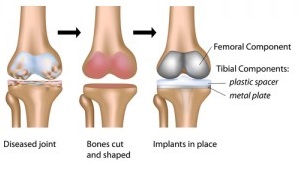When the cartilage has worn away in the knees, an artificial knee can replace it. In bilateral knee replacement surgery, the surface of the damaged lower leg and the thigh bone is removed. The damaged ends of the bones are shaved off and replaced with new plastic and metal surfaces. The knee replacement restores almost all normal function of the knee, and its goal is mainly to relieve pain, help straighten the limbs, and restore a normal range of motion to the knees.
2 Types of Bilateral Knee Replacement
This is a surgery that replaces both of the knees due to pain and damage. It can be accomplished on the same day, or staged one knee at a time.

Simultaneous Bilateral Total Knee Replacement
A knee replacement procedure simultaneously replaces both damaged knees in a single day with one single anesthesia.
- Benefits: The surgical event only requires single hospital stay and one rehabilitation period to heal both knees.
- Complications: Only patients in a good health are appropriate candidates for replacing two knees at the same time because it includes risks of cardiovascular complications, may need banked blood after surgery, and require a longer rehabilitation time.
Staged Bilateral Total Knee Replacement
A staged bilateral knee replacement procedure is defined as two, separate surgical events taking place for one knee at a time, and the surgeries are typically performed several months apart.
- Benefits: The advantages include less stress on the cardiovascular system so the chances of complication related to the heart and deep veins are reduced. You may not need banked blood and experience less pain. This is the perfect choice for those with vascular, cardiac or pulmonary diseases or people over 80 years old.
- Complications: Staged knee surgery means that you have to go through the procedure twice. Meaning two hospital stays, two periods of anesthesia, and two rehabilitations that may extend your disability time.
How to Recover from Bilateral Knee Replacement
A lot of hard work is involved in a full recovery from this replacement surgery. Every precaution and exercise must be strictly adhered to for the best possible outcome.
1. Pain Management
Short-term recovery is defined as the period from your surgery to the time when you can begin physical therapy. During this time you will experience a great deal of pain, and the doctor or nurse will usually provide you with oral painkillers. However if the pain becomes intolerant, you can request something more powerful from your doctor to help ease the pain.
2. Proper Exercise
As you begin to recover from surgery, doctor may order low intensity exercises that will prevent blood clots from forming in your veins. For example, you will be encouraged to move your leg and slightly bend your knee. The nurse will assist you in other daily exercises that improve movements and help finalize the healing of your new joints in preparation for physical therapy.
3. Physical Therapy
Within the first 6 weeks after bilateral knee replacement, you should be ready for physical therapy which allows for a natural transition back to the normal knee movement. Those that dedicate themselves to the physical therapy exercises usually recover faster than those that are reluctant to push themselves. The average time a person is in physical therapy is anywhere from 6 to 12 weeks. When finished, you should be able to resume almost all normal activities without any pain.
4. Full Recover
Long-term recovery is defined as 3 to 6 months after the surgery, when the surgical wounds and the internal soft tissues are complete healed. Most people are ready to return to work and have resumed all normal activities without any limitations. However some swelling of the feet could continue up to a year after corrective surgery.
5. Follow-Up Care
Even after you have achieved a full recovery, you will have to take precautions for the rest of your life. You will be more prone to infections and will need to make your dentist and future doctors aware that you have had bilateral knee replacement before any major dental or invasive procedures are carried out. They can take pro-active measures that help prevent infections from settling into your new joints. You will need to discuss with your doctor beforehand about sports activities, such as tennis, jogging or heavy lifting (40 lbs or more), which may strain an already weakened knee. When going through screening at airports, you may trigger metal detectors. Fortunately, you may be given a card to certify you have a metal knee replacement.
